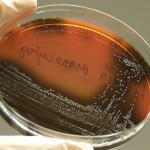A recent study by DVM Annukka Markkula and colleagues showed that three DEAD-box RNA helicases are needed for cold-temperature growth of Listeria monocytogenes. Deletion of single DEAD-box RNA helicase genes increased the minimum growth temperature and dramatically decreased the growth rate of L. monocytogenes at 3˚C. In addition, deletion of helicase genes reduced the motility of L. monocytogenes. The study was published in valued Environmental Microbiology journal.
Environ Microbiol 2012, Early View, doi:10.1111/j.1462-2920.2012.02761.x
Markkula A, Mattila M, Lindström M, and Korkeala H.
Department of Food Hygiene and Environmental Health, University of Helsinki
Genes encoding putative DEAD-box RNA helicases in Listeria monocytogenes EGD-e are needed for growth and motility at 3˚C
The study showed that the relative expression of all four DEAD-box RNA helicase-encoding genes of L. monocytogenes EGD-e was increased at 3˚C. The growth rate of three deletion mutant strains was decreased at 25˚C compared to that of the wild type L. monocytogenes EGD-e. At 3˚C the growth of three mutant strains was virtually impaired. Deletion of the genes increased the minimum growth temperature of strains by 4.9-8.8˚C. A total of two cold sensitive deletion mutant strains were impaired in motility. Motility of a cold-sensitive strain was decreased approximately by half compared to the wild type EGD-e.
The study shows that three DEAD-box RNA helicases have an important role in cold tolerance and motility of L. monocytogenes EGD-e. The role of one DEAD-box RNA in cold tolerance and motility is negligible.
DEAD-box RNA helicases are found in most living organisms and are involved in various aspects of RNA metabolism from transcription to RNA decay. DEAD-box RNA helicases have recently been linked to cold tolerance of some bacteria. At cold temperatures stability of RNA secondary structures, like RNA duplexes increases. DEAD-box proteins function as helicases that separate short duplex regions of RNA.
The research was carried out at the Finnish Centre of Excellence in Microbial Food Safety Research and supported by the Finnish Graduate School on Applied Bioscience and the Walter Ehrström Foundation.
